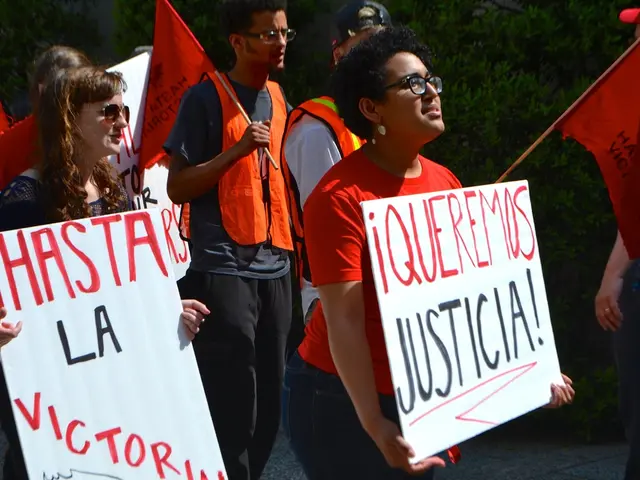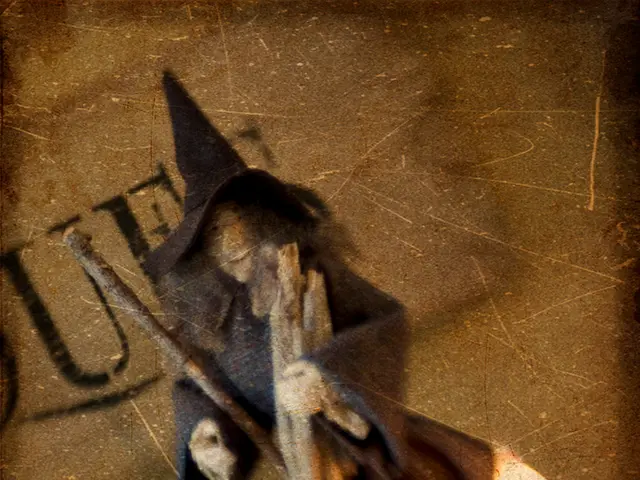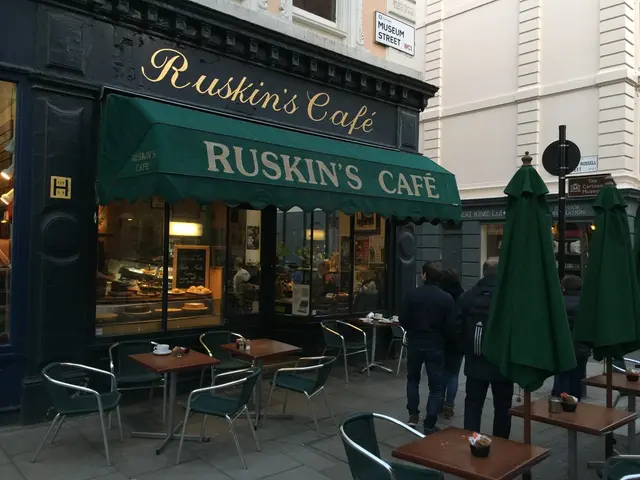Weimar Berlin's Romanisches Café: A Rekindled Glimpse into a Historic Watering Hole
Hangin' at the Romanisches: The Heart of Weimar Berlin's Intellectual Scene
In a city filled with book publishers, cabarets, and cinemas, the Romanisches Café on Kurfürstendamm stood out as a haven for artists, playwrights, and intellectuals during Weimar Berlin's golden age. So, why was this ordinary-seeming cafeteria the hotspot for the city's elite?
It all started with a little something we call curiosity. The establishment boasted a comprehensive set of Brockhaus encyclopedias on its main floor, which proved an irresistible draw for the city's intellectual wonders. These encyclopedias served as an endless source of inspiration and fueled countless debates, transforming what could have been just another stuffy café into a lively intellectual marketplace.
The comfort factor wasn't too shabby either. Each table had its own ink, and you could pretty much choose any newspaper you wanted, brought to you by a bustling waiter. Now that's service!
Fast forward to today, and you can get a taste of the Romanisches vibe in the Europa Center's Romanisches Café exhibition. "This is where the thinkers put pen to paper," says curator Katja Baumeister-Frenzel. "They were crafting plays, books, whatever ideas they possessed. Back then, most people rented rooms from landladies, and visitors weren't generally allowed. Cafés were their only escape."
If you've got a certain mental image of 1920s Berlin in your head (probably something along the lines of George Grosz caricatures or Babylon Berlin-style cabaret and flapper girls), this exhibition manages to provide a refreshingly authentic glimpse into the cultural vibrancy of the era. "Under the Kaiser, things were always censored," says Baumeister-Frenzel. "But when he was ousted, everything changed. Intellectual activity exploded."
In fact, by 1920, Berlin had over 200 book publishers, 70 cabaret stages, countless theaters, and more than 50 daily newspapers. Old photos of the Romanisches Café show newspaper shelves extending all the way to the ceiling. "It was a hotspot for daily newspapers," Baumeister-Frenzel notes. "Everyone from famous reporters to everyday readers dug into the news here."
The Romanisches Café was like a well-stirred melting pot, where artists, thinkers, and writers of all kinds mixed and mingled. However, the café wasn't your average anarchy-fest. It was divided into two distinct sections: the “swimmers,” who were the high-profile regulars, and the “non-swimmers,” who mingled more freely. Each group had its own set of rules and expectations, although there was some overlap when it came to the good stuff – like the latest news, good conversation, and maybe even a bit of gossip.
The Romanisches Café's cultural life was already being romanticized in 1927, when a performance entitled Bei uns um die Gedächtniskirche rum was put on. Its allure remained strong enough to catch the attention of the Nazis, who accused the café's patrons of plotting a Bolshevik uprising in 1926. The exhibition currently at the Europa Center has carefully re-created many of the Romanisches Café's original features, despite some challenges. "The building was largely destroyed during an air raid in 1943," Baumeister-Frenzel explains. "So we had to do a lot of detective work to figure out what it once looked like."
The exhibition features authentic touches, like a matchholder-cum-ashtray that once sat on every table, the same thick-stemmed glass serving dish used for the cafe’s signature snack “Eier im Glas,” and even an original coffee cup with the name “Romanisches Café” written in pale-green letters.
Sadly, the Romanisches Café's golden age ended a decade before its physical destruction. Many of its patrons were forced to flee the city or succumb to the harsh realities of the Nazi regime, which marked the beginning of the café's slow, tragic decline. One of the most poignant accounts of the Romanisches Café comes from German author Wolfgang Koeppen, who describes the deflated husk of the café in its post-Golden Age days. "The guests of the cafe had scattered all over the world, or were captured or killed or took their own lives, or cowered and still sat in the café with tawdry reading material, ashamed of ... the great betrayal ... When they spoke with each other, they whispered, and when they left, they regretted that they had only whispered..."
Koeppen was there to witness the café's final days, as well as the devastating air raid that ultimately brought it to its knees. In a twist of irony, the café's destruction was met with a sense of victory – a fiery, defiant symbol of the city's spirit that would never be broken. The Romanisches Café burned brightly, like the Oriflamme of a secret fatherland, until it was nothing more than embers in the wind.
Today, the Romanisches Café can be found indefinitely at the Europa Center, Tauentzienstr. 9-12, Charlottenburg. "We're still writing, we're still thinking, we're still fighting for what's right," says Baumeister-Frenzel with a determined smile. The Romanisches legacy lives on, not just in Berlin, but in every corner of the world where people gather to share ideas, dreams, and the challenges of the human experience.
- In contemporary times, the intellectual vibe of the Romanisches Café can be experienced at its replica in the Europa Center, a testament to its historical significance in fashion-and-beauty and education-and-self-development.
- The Romanisches Café was not only a hub for intellectual activity but also a melting pot of lives, showcasing personal-growth and career-development through vibrant discussions, ideas, and debates.
- The café's grandeur extended beyond intellectual pursuits, with an extensive selection of newspapers for both famous journalists and everyday readers, catering to the city's food-and-drink and weather enthusiasts alike.
- For those interested in the city's rich cultural history, architecture, and home-and-garden, the exhibition at the Europa Center offers a meticulously restored representation of the original Romanisches Café's features, down to the matchholder-cum-ashtray and the signature glass serving dish.
- Weimar Berlin, a city known for its publishing industry, boasted over 200 book publishers, indicating a flourishing industry centered on education, knowledge, and ideas – a testament to the era's commitment to learning and self-improvement.
- As the city's intellectual hotspot, the Romanisches Café was often the backdrop for the city's lively social scene, with numerous relationships and acquaintances formed beyond intellectual connections, delving into the realm of sports and travel as well.








